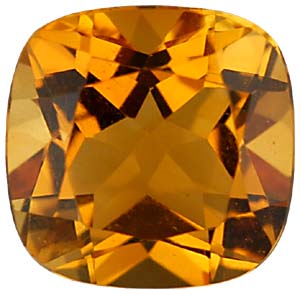The Gemstone Citrine

Citrine is the yellow to orange variety of Quartz. Natural Citrine is not common; most Citrine on the gem market is produced by heat treating Amethyst and Smoky Quartz. It takes a relatively low temperature to change the color light to golden yellow, and heating to higher temperatures will give the stone a darker yellow to brownish-red color. The name Citrine is derived from the citron fruit, a yellow fruit similar to the lemon. (In fact, citron means "lemon" in several languages.)
Color
?
Yellow, Orange, Brown
Additional Properties
|
Refractive Index
?
1.54 - 1.55 |
Double Refraction
?
.009 |
Transparency
?
Transparent |
SG
?
2.63 - 2.65 |
Luster
?
Vitreous |
| Cleavage ?
Indiscernible |
All About
Most
heat treated Citrine takes on a deep orange or slightly reddish tint. In general, the deeper colored stones are the most valuable, including those with reddish tints. Lightly colored yellow Citrine can occur naturally but is rare; the intense yellow form is usually
irradiated and given the trade name of "Lemon Quartz".
Citrine is a very affordable gemstone, and all its color ranges are not expensive. It is most often confused with orange-yellow
Topaz, which is very similar in color and body. Topaz is the more valuable gemstone, and dealers often sell Citrine labeled as Topaz. Several false trade names for Citrine are "Madeira Topaz", "Gold Topaz", and "Bahia Topaz". However, some fine and rare Citrine gemstones have a pure yellow color that is rarely duplicated by golden Topaz.
Citrine can be found in large crystals, and
flawless gems of all sizes have been cut. A natural mixture of purple Amethyst and golden Citrine has been coined with name "Ametrine". (See the
Ametrine gemstone page for more details.)
Uses
?
Citrine is cut into all different types of gems, especially oval and rectangular cuts. It is a very popular pendant stone as
flawless stones of many
carats are not uncommon. It is used as a centerpiece for rings, and also for earrings, bracelets, and necklaces. Lesser quality Citrine combined with white Quartz is also tumbled and used as beads for necklaces and bracelets.
Treatments & Enhancements
?
Virtually all gem Citrine is not naturally colored, but rather colored from
heat treatment of
Amethyst. Heating Amethyst at about 750 degrees Fahrenheit will produce a mild yellow color, and heating to about 1700 degrees products deep orange to reddish colors. Most heat treated Citrine has a reddish tint. The intense yellow shades often known as
Lemon Quartz are usually formed by
irradiation of Quartz. Synthetic Citrine gems are also produced using the
hydrothermal method, and these are usually in intensely vivid colors.
Citrine Sources
?
Brazil is the largest producer of Citrine. Other sources are Argentina, Madagascar, Zaire, Namibia, Spain, and Russia.
Similar Gemstones
?
Citrine can be difficult to distinguish from yellow and orange
Topaz. Citrine may also be confused with yellow
Sapphire, which is usually a purer yellow and much harder, and can also be confused with
Golden Beryl known as Heliodor. Some
Grossular Garnets may also have a similar color to orange-red Citrine.
Citrine in the Rough Photos
?